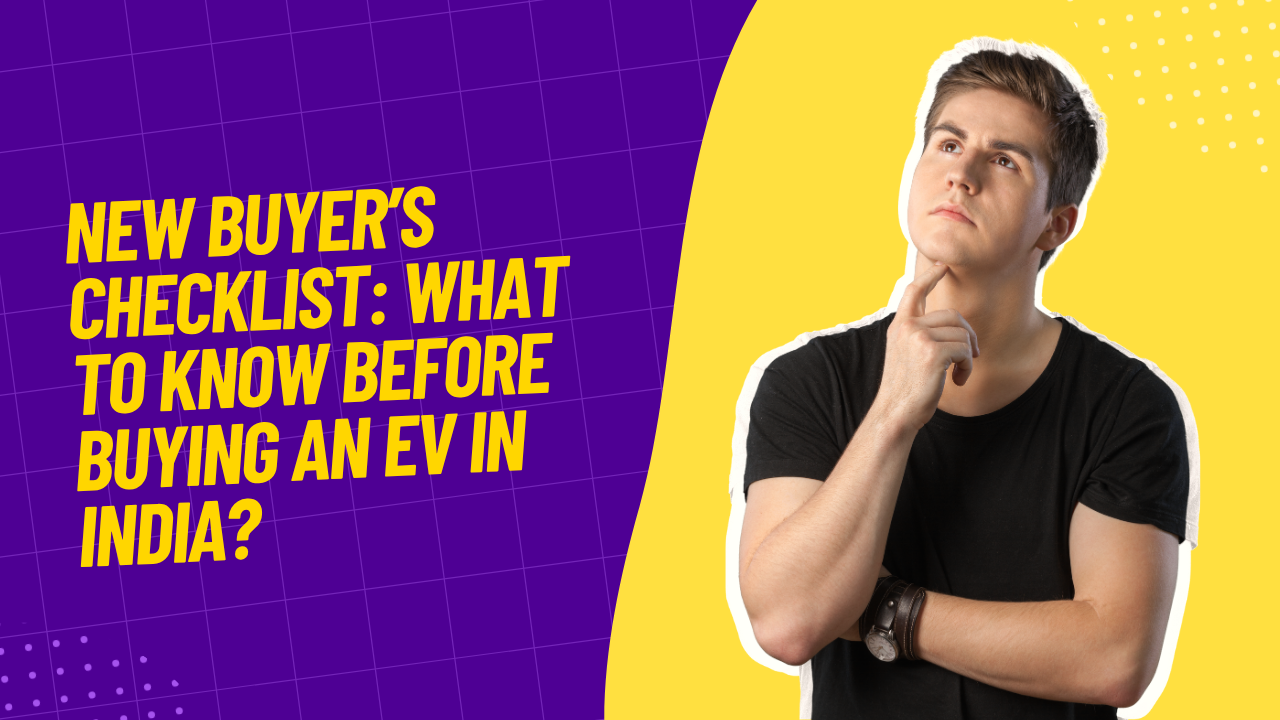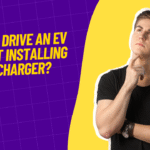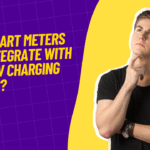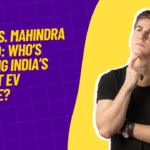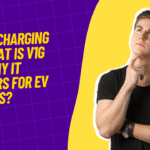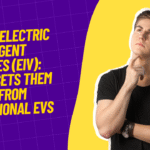The electric vehicle (EV) revolution in India is accelerating. With rising fuel costs, expanding charging infrastructure, and aggressive government policies on EV adoption, prospective buyers find themselves at a crucial decision point. Before you choose your first EV, it’s essential to arm yourself with knowledge. This comprehensive checklist covers everything—from budgeting and features, to subsidies and charging setup—helping you make a confident, future-proof investment.
2. Budget & Total Cost of Ownership (TCO)
2.1 On-Road Price vs Ex-Showroom Price
EVs often include subsidies from the central and state governments. Ensure you verify the on-road price—this margin can affect affordability more than base vehicle cost.
2.2 Insurance & Road Tax
Most states provide EV-specific road tax waivers or reduced registration costs. Electric vehicle insurance may be 10–20% cheaper than ICE counterparts.
2.3 Fuel vs Electricity
Estimate your monthly travel (km) to calculate whether electricity per km (around ₹0.40–0.50) makes financial sense compared to petrol (₹2.00–₹2.50 per km).
2.4 Depreciation & Resale Value
EV depreciation patterns differ from petrol cars. Most EVs lose about 30–40% of their value in the first three years and then stabilize. Picking a reputable brand helps preserve resale value.
3. Charging Infrastructure
3.1 Home Charging Setup
Decide between:
- Standard 15A plug
- Dedicated 3.3 kW wall charger
A home charger provides convenience but may need a 6–8 hour charge window.
3.2 Public Charging Network
Check for public chargers near home or work. OEM-provided fast charging networks (like Tata Power EZ Charge, Ather Grid, and Ionet) are expanding across cities.
3.3 DC Fast Charging vs AC Charging
DC fast chargers (25–50 kW) can charge 80% of battery in 30–45 minutes. Not essential for daily use but useful for long trips.
4. Choosing the Right Range & Battery
4.1 Real-World vs ARAI Range
Manufacturers provide ARAI range; actual range depends on drive style, weather, terrain, and cabin conditions. Subtract 15–20% from ARAI estimates for real-world use.
4.2 Battery Chemistry & Longevity
NMC and LFP chemistries offer different life cycles. NMC offers energy density but may degrade faster; LFP lasts longer with a larger battery pack but heavier build.
4.3 Battery Warranty
Most OEMs provide 8-year or 160,000 km battery warranty. Prefer vehicles with that coverage for peace of mind.
5. Vehicle Performance & Practicality
5.1 Acceleration & Power
Electric torque offers rapid acceleration from standstill. Test drive in city and highway to assess comfort and stability.
5.2 Cabin Space & Comfort
Without a traditional engine, EVs can offer generous cabin space. Check headroom, legroom, and boot capacity.
5.3 Ride Quality & Handling
EVs are heavier due to battery packs. Test drive over potholes, speed breakers, and inclines to judge chassis setup and stability.
6. Safety & Technology Features
6.1 ADAS & Driver Assist
Look for features like lane keep assist, adaptive cruise control, 360-degree parking view, and semi-autonomous driving—now available in mid-range EVs.
6.2 Crash Safety Ratings
Refer to Global NCAP or regional crash tests. Some models include six airbags, ESC, TPMS, and pedestrian detection.
6.3 OTA & Software Updates
OTA updates extend vehicle features and performance over time. Confirm access to regular software upgrades and app support.
7. Subsidies, Incentives & Policy Support
7.1 Central Schemes: FAME II/BEE
FAME II provides incentives up to ₹1.5 lakh on four-wheeler EVs. Confirm eligibility based on battery capacity and amount.
7.2 State Government Incentives
State schemes vary widely—Maharashtra, Delhi, Tamil Nadu offer substantial EV subsidies. Check subsidy slabs and deadlines.
7.3 Scrappage Bonus Schemes
Some states waive road tax if you scrap an old ICE car when buying an EV. A smart option for owners of old four-wheelers.
8. After-Sales Support & Service Network
8.1 Dedicated EV Service Centers
EVs need minimal maintenance, but service network is crucial. Choose brands with at least one depot within 50 km.
8.2 Battery & Parts Availability
Validate spare part supply, especially for battery components. Dealer support and quick replacement enhance reliability.
8.3 Mobile Servicing & Home Repairs
Many OEMs offer mobile vans for software updates and basic diagnostics. This convenience can save time and effort.
9. Financing & Loan Offers
9.1 Green Loans & Lower Interest
Banks provide green loans for EVs at lower interest and longer tenors. Benefit from EMI subsidies during festivals and fiscal-year-end.
9.2 EMI Structures & Exchange Bonuses
Look for zero down-payment campaigns. Inquire about exchange programs—some dealers offer ₹50,000–1,00,000 off for an old combustion car.
10. Brand & Model Considerations
10.1 Reputation & OEM Stability
Prioritize brands with solid track records—Tata, MG, Hyundai, BYD, Mahindra. They offer network reach and sustainability.
10.2 Future-Proof Platform
EV platforms are evolving rapidly. Prioritize vehicles built on modular architecture with space for capacity upgrades and future tech.
10.3 Community & Peer Feedback
Participate in owner forums and social media groups. Real-world experience often reveals maintenance quirks and useful tips.
11. Sample Pre-Purchase Checklist
- Confirm real-world range after battery inefficiency adjustments.
- Check available charging options at home and office.
- Evaluate state subsidies and central scheme eligibility.
- Test ride on varied terrain to check handling.
- Verify battery health (voltage, SoC variances).
- Ensure service support is within 50 km radius.
- Compare green loan offers and EMI impact.
- Check for ADAS and OTA compatibility.
- Poke the service engineer about software update frequency.
- Research resale trends for your shortlisted model.
12. Frequently Asked Questions (FAQ)
Q1: Do I need to install a home EV charger?
A proper home charger is ideal for convenience and speed. A 3.3 kW wall charger can charge most EVs overnight, whereas a regular household socket can take up to 10–12 hours.
Q2: When will my EV battery degrade?
Expect 10–15% degradation over the first three years. Most EVs come with battery management systems that preserve longevity. Genuine care (e.g., avoiding extreme charging) helps extend life.
Q3: Are EVs safe in India’s climate?
Yes. EV batteries are temperature-sealed and tested for Indian weather. Heat management systems in cars like Tata Nexon EV and Hyundai Kona provide reliability during hot and monsoon seasons.
Q4: Can I drive an EV on long trips?
Yes, as long as you plan route with DC fast chargers. Apps like PlugShare and NextCharge map available stations. Expect charging stops every 200–300 km, similar to petrol refueling breaks.
Q5: How do I sell my EV later?
Resale demand is rising, especially for models with known battery longevity. Maintain service and charge logs. Brands with strong networks tend to fetch better resale prices.
Q6: Is EV insurance more expensive?
No. EV insurance often costs slightly less. Coverage for battery and motor components is included in comprehensive policies—ensure they are clearly listed.
13. Conclusion: Your EV Journey Starts Here
Buying your first EV in India is an empowering and sensible choice. Armed with this checklist—covering cost, charging, government support, technology, and servicing—you’re ready to make a confident decision. Consider test-driving multiple models, understand upcoming policy updates in your state, and plan your cost-of-ownership carefully.
